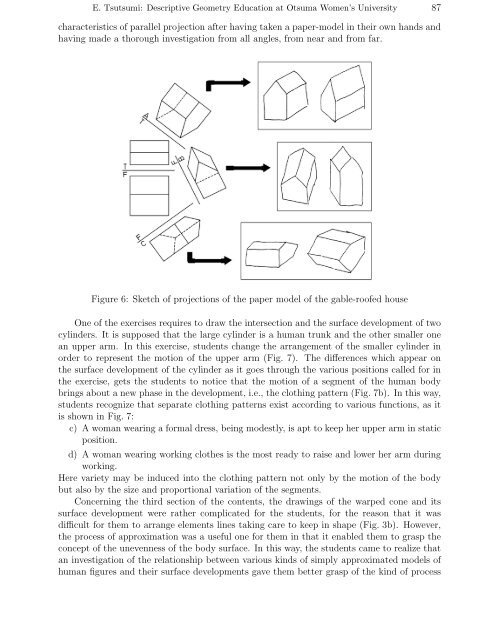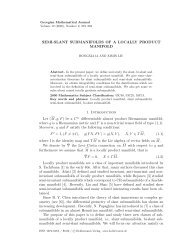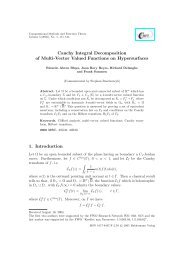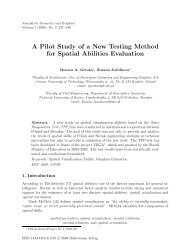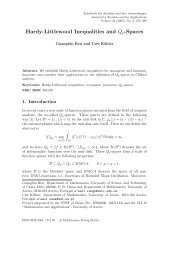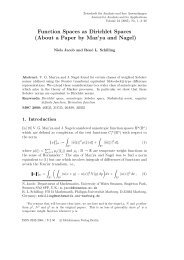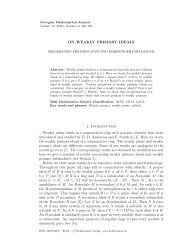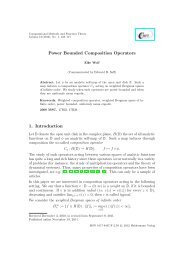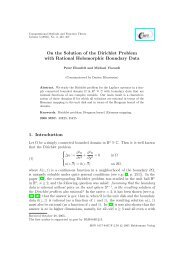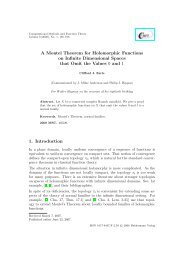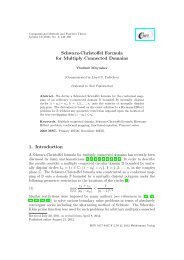Descriptive Geometry Education at the Department of Clothing and ...
Descriptive Geometry Education at the Department of Clothing and ...
Descriptive Geometry Education at the Department of Clothing and ...
You also want an ePaper? Increase the reach of your titles
YUMPU automatically turns print PDFs into web optimized ePapers that Google loves.
E. Tsutsumi: <strong>Descriptive</strong> <strong>Geometry</strong> <strong>Educ<strong>at</strong>ion</strong> <strong>at</strong> Otsuma Women’s University 87<br />
characteristics <strong>of</strong> parallel projection after having taken a paper-model in <strong>the</strong>ir own h<strong>and</strong>s <strong>and</strong><br />
having made a thorough investig<strong>at</strong>ion from all angles, from near <strong>and</strong> from far.<br />
Figure 6: Sketch <strong>of</strong> projections <strong>of</strong> <strong>the</strong> paper model <strong>of</strong> <strong>the</strong> gable-ro<strong>of</strong>ed house<br />
One <strong>of</strong> <strong>the</strong> exercises requires to draw <strong>the</strong> intersection <strong>and</strong> <strong>the</strong> surface development <strong>of</strong> two<br />
cylinders. It is supposed th<strong>at</strong> <strong>the</strong> large cylinder is a human trunk <strong>and</strong> <strong>the</strong> o<strong>the</strong>r smaller one<br />
an upper arm. In this exercise, students change <strong>the</strong> arrangement <strong>of</strong> <strong>the</strong> smaller cylinder in<br />
order to represent <strong>the</strong> motion <strong>of</strong> <strong>the</strong> upper arm (Fig. 7). The differences which appear on<br />
<strong>the</strong> surface development <strong>of</strong> <strong>the</strong> cylinder as it goes through <strong>the</strong> various positions called for in<br />
<strong>the</strong> exercise, gets <strong>the</strong> students to notice th<strong>at</strong> <strong>the</strong> motion <strong>of</strong> a segment <strong>of</strong> <strong>the</strong> human body<br />
brings about a new phase in <strong>the</strong> development, i.e., <strong>the</strong> clothing p<strong>at</strong>tern (Fig. 7b). In this way,<br />
students recognize th<strong>at</strong> separ<strong>at</strong>e clothing p<strong>at</strong>terns exist according to various functions, as it<br />
is shown in Fig. 7:<br />
c) A woman wearing a formal dress, being modestly, is apt to keep her upper arm in st<strong>at</strong>ic<br />
position.<br />
d) A woman wearing working clo<strong>the</strong>s is <strong>the</strong> most ready to raise <strong>and</strong> lower her arm during<br />
working.<br />
Here variety may be induced into <strong>the</strong> clothing p<strong>at</strong>tern not only by <strong>the</strong> motion <strong>of</strong> <strong>the</strong> body<br />
but also by <strong>the</strong> size <strong>and</strong> proportional vari<strong>at</strong>ion <strong>of</strong> <strong>the</strong> segments.<br />
Concerning <strong>the</strong> third section <strong>of</strong> <strong>the</strong> contents, <strong>the</strong> drawings <strong>of</strong> <strong>the</strong> warped cone <strong>and</strong> its<br />
surface development were r<strong>at</strong>her complic<strong>at</strong>ed for <strong>the</strong> students, for <strong>the</strong> reason th<strong>at</strong> it was<br />
difficult for <strong>the</strong>m to arrange elements lines taking care to keep in shape (Fig. 3b). However,<br />
<strong>the</strong> process <strong>of</strong> approxim<strong>at</strong>ion was a useful one for <strong>the</strong>m in th<strong>at</strong> it enabled <strong>the</strong>m to grasp <strong>the</strong><br />
concept <strong>of</strong> <strong>the</strong> unevenness <strong>of</strong> <strong>the</strong> body surface. In this way, <strong>the</strong> students came to realize th<strong>at</strong><br />
an investig<strong>at</strong>ion <strong>of</strong> <strong>the</strong> rel<strong>at</strong>ionship between various kinds <strong>of</strong> simply approxim<strong>at</strong>ed models <strong>of</strong><br />
human figures <strong>and</strong> <strong>the</strong>ir surface developments gave <strong>the</strong>m better grasp <strong>of</strong> <strong>the</strong> kind <strong>of</strong> process


